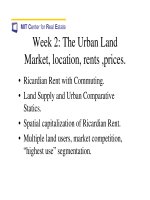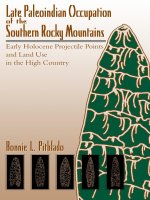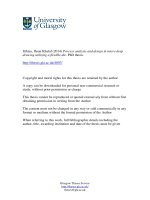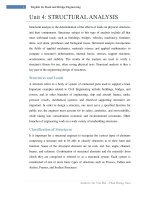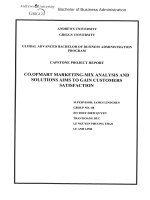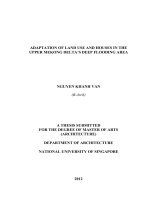Floristic composition, structural analysis and land use
Bạn đang xem bản rút gọn của tài liệu. Xem và tải ngay bản đầy đủ của tài liệu tại đây (1.68 MB, 256 trang )
Floristic Composition, Structural Analysis and Land
Use/Land Cover Change in Bore-Anferara-Wadera
Forest, Southern Ethiopia
Mesfin Woldearegay
Addis Ababa University
Addis Ababa, Ethiopia
June 2017
Floristic Composition, Structural Analysis and Land Use/Land Cover
Change in Bore-Anferara-Wadera Forest, Southern Ethiopia
Mesfin Woldearegay Ahmed
A Dissertation Submitted to
The Department of Plant Biology and Biodiversity Management
Presented in Partial Fulfillment of the Requirements for the Degree of
Doctor of Philosophy (Biology: Botanical Sciences)
Addis Ababa University
Addis Ababa, Ethiopia
June 2017
ADDIS ABABA UNIVERSITY
GRADUATE PROGRAMMES
This is to certify that the Dissertation prepared by Mesfin Woldearegay Ahmed, entitled:
Floristic Composition, Structural Analysis, and Land Use/Land Cover Change in BoreAnferara-Wadera Forest, Southern Ethiopia, and submitted in partial fulfillment of the
Requirements for the Degree of Doctor of Philosophy (Biology: Botanical Sciences)
complies with the regulations of the University and meets the accepted standards with
respect to originality and quality.
Signed by Research Supervisors:
Name
Signature
Date
1. __________________________
_________________
_____________
2. ___________________________
_________________
_____________
3. ____________________________
_________________
_____________
4._____________________________
__________________
_____________
_____________________________________________ _______________
Chair of Department or Graduate Programme Coordinator
Abstract
Floristic Composition, Structural Analysis and Land use/Land Cover Change in BoreAnferara-Wadera Forest, Southern Ethiopia
Mesfin Woldearegay Ahmed, Ph.D. Dissertation
Addis Ababa University, 2017
This study was conducted in Bore-Anferara-Wadera forest, southern Ethiopia, to
investigate the floristic composition, vegetation structure, regeneration status and land
use/land cover change. Vegetation data were collected from 112, 30 m x 30 m sample
plots laid for trees at every 400 m distance along line transects and 5 m x 5 m and five 1
m x 1 m subplots for saplings and herbs, respectively. The regeneration status of woody
species was assessed by employing total count of all seedlings within the main sample
plot. Environmental variables such as altitude, slope, and exposure were measured in
each sample plot. Soil samples were taken from two layers (0-25 and 25-50 cm) at five
points in each sample plot and soil sample from these five points were mixed to form a
composite sample. In each sample plot, woody species ≥ 3 m were counted and cover
abundance values estimated as well as height and diameter at breast height were
measured. Hierarchical cluster analysis was used to identify plant communities and
synoptic values for identification of the dominant species for naming plant communities.
Density, frequency, basal area and importance value index (IVI) of woody species were
also computed. Shannon-Wiener diversity index was used to assess species richness and
evenness. Sorensen's similarity coefficient was used to measure similarities among
communities and between Bore-Anferara-Wadera and eight Afromontane forests in
Ethiopia. Canonical correspondence analysis (CCA) was used to assess the relationship
between plant community types and environmental variables. Moreover, three periods
land sat images (1986 TM, 2000 ETM+ and 2014 OLI/TIRS) were acquired and analyzed
by using remote sensing and GIS technologies to generate information on the temporal
changes in land use and land cover types. A total of 136 vascular plant species belonging
to 119 genera and 63 families were recorded. About 4.4% of the species were endemic to
Ethiopia and 11.8 % of the species were new records for the Sidamo floristic region of
the flora area. The overall Shannon-Wiener diversity and evenness values of BoreAnferara-Wadera forest were 3.84 and 0.78, respectively. Size class distribution of
woody species across different DBH and height classes indicated the relatively high
proportion of individuals at lower classes, indicating impacts of past disturbance.
Analysis of population structure and regeneration status of the forest revealed various
patterns of population dynamics where some species were represented by few mature
plants only suggesting that they are on the verge of local extinction and thus immediate
conservation measures should be taken. Community classification using the free
statistical software R version 3.1.1 resulted in four, namely Acanthus eminens Dracaena afromontana, Syzygium guineense subsp. afromontanum - Ocotea kenyensis,
Pouteria adolfi-friederici - Psychotria orophila and Scolopia theifolia - Teclea nobilis
community types. Canonical correspondence analysis (CCA) result showed that altitude
and slope were among the main environmental variables in determining patterns of
species distribution and plant community formation. The results of land sat image
iii
analysis revealed that agricultural land and built up area are expanding rapidly at the
expense of other land use and land cover types. Forest and shrub land areas have
declined drastically over the last 28 years. Population pressure, deforestation, land
tenure system, and forest fire were the main driving forces responsible for the change in
land use and land cover types in the study area. Therefore, a joint management and
conservation measures should be taken by the government, local people and other
stakeholders in order to reduce and/or stop the fast rate of vegetation cover declining
and sustainable utilization of the forest resources in the study area.
Keywords: Anferara, Biodiversity, Conservation, Land use/land cover, Plant community
iv
DEDICATION
I would like to dedicate this dissertation to my wife Mekdes Gerawork and my children
Samuel and Hemen Mesfin for their unreserved support, encouragement and patience
over the years, and to my parents who did not enjoy formal education but strongly
committed to teach their children hoping that their future will be better off.
v
ACKNOWLEDGMENTS
I would like to express my sincere gratitude to my supervisors Prof. Zerihun Woldu and
the late Prof. Ensermu Kelbessa for their unreserved guidance, comments, support and
effective follow-up of the research work. I am also very much grateful for their openness
and friendly approach, encouragement, valuable suggestions and effective academic
assistance in the whole progress and completion of my Ph.D. work.
I would like to thank Debre Birhan University (DBU) for sponsoring me for this Ph.D.
study and provision of additional financial support for the completion of the study. I
would like to extend my thanks to the Graduate Programmes of Addis Ababa University
for funding the cost of all the research work.
I am obliged to pass my deepest thanks to Oromia Region Forest and Wildlife Enterprise,
Borena-Guji Forest and Wildlife Enterprise, Adola Wayu District, Anasora District and
Wadera District Administration offices for their hospitality and permission to conduct
this research project. I greatly acknowledged the Kebele Administration officers of the
study sites for their support and assistance in the field work. I would like to extend my
deepest gratitude to the Department of Plant Biology and Biodiversity Management,
Addis Ababa University (AAU) for facilitating the study; the technical staff members of
the National Herbarium (ETH) for their kind help for all aspects of the herbarium work;
the National Meteorological Service Agency of Ethiopia and Ethiopian Mapping Agency
for providing meteorological data and map of the study area, respectively.
vi
The local people inhabiting in and around the forests are greatly acknowledged for
unreservedly sharing with me their knowledge of the wild flora and possible driving
forces for the land use and land cover change that occurred in the study area and for their
kind assistance during data collection. Ato Dagne Negussie (Head of Forest Development
& Utilization Department in Borena-Guji Forest and Wildlife Enterprise), Ato Tepissa
Girja (Head of Culture & Tourism at Adola Wayu District) Ato Teglu Abate (Expert at
Borena-Guji Forest and Wildlife Enterprise) and Ato Ashebir Abebe (Expert at BorenaGuji Forest and Wildlife Enterprise) are truly acknowledged for their valuable
information in land use and land cover change trends and the natural vegetation in the
study area.
I am very thankful to my friend Dr. Ermias Lulekal for giving valuable comments by
reading the dissertation besides his encouragement, support, and advice on how to tackle
the course work and the research activities to this end. I also extend my heartfelt thanks
to Ato Yosef Samuel for his assistance in land use and land cover change data analysis,
kind hospitality at his home during field work and continuous support and advice to
accomplish this Ph.D. work. My friend Ato Amanuel Abate is also truly acknowledged
for providing comments by reading the land use and land cover change part of the
dissertation. I also thank Ato Solomon Tadesse, DBU staff member, for allowing me to
use his office during dissertation write-up.
I am very much indebted to my wife Mekdes Gerawork for her devotion to take all the
family burden and household responsibility patiently beside her support, encouragement
vii
and prayers throughout the study period, and my children Samuel and Hemen Mesfin for
their love. My father Woldearegay Ahmed, my mother Worknesh Tegegne, my brothers
and sisters Bahirwossen W/aregay, Tesfaye W/aregay, Belay W/aregay, Zufan W/aregay,
Hana W/aregay, Tweodros W/aregay, Tigist W/aregay and Moges W/aregay for their
support, encouragement and prayers throughout the study period. My mother Fetlework
Demise is truly acknowledged for her concern about my health and prayers during my
study period. I also extend my thanks to Sinkie Bekele for her support and taking care of
my child and the family. My friends Wossen Ayalew, Eyob Tenkir, Abrham Assefa,
Talemos Seta, Getachew W/michael, Habtu Woldu, Habtie Telila, Abiyu Tilahun, Abiyot
Dibaba, Seyoum Abebe, Wondwossen Abi, Andualem Taye, Getu Nigussie, Yemane
W/tsadik and Bizuayehu Tadesse are truly acknowledged for their support and
encouragement to this end.
I am very grateful to a number of friends, colleagues and people with whom I had
valuable discussions about the course and research work, and from whom I obtained
support on various aspects of this study.
Above all, I thank the Almighty God for His unspeakable gift to this point. I am also very
much indebted to thank St. Mary, the mother of Lord Jesus Christ, who is with me at all
times and in all circumstances.
viii
Table of Contents
LIST OF FIGURES..................................................................................................................................xiii
LIST OF TABLES....................................................................................................................................xiv
LIST OF APPENDICES ............................................................................................................................xv
LIST OF ACRONYMS.............................................................................................................................xvi
CHAPTER ONE ..............................................................................................................................................1
1.
INTRODUCTION....................................................................................................................................1
1.1 Background ................................................................................................................................... 1
1.2 Research questions and objectives ............................................................................................... 5
1.2.1
Research questions ....................................................................................................... 5
1.2.2
Research objectives ...................................................................................................... 6
CHAPTER TWO ............................................................................................................................................. 8
2.
LITERATURE REVIEW ............................................................................................................................8
2.1 Plant diversity ................................................................................................................................. 8
2.1 The vegetation types of Ethiopia .................................................................................................. 9
2.2 Threats to plant diversity in Ethiopia .......................................................................................... 12
2.3 Plant community theories........................................................................................................... 15
2.3.1
The community-unit theory (The discrete community concept)................................ 17
2.3.2
The continuum theory (The individualistic concept) .................................................. 18
2.4 Community diversity, evenness and richness ............................................................................. 20
2.4.1
Community diversity ................................................................................................... 20
2.4.2
Species richness .......................................................................................................... 20
2.5 Measures of community diversity .............................................................................................. 21
2.6 Multivariate data analysis ........................................................................................................... 24
2.6.1
Classification ............................................................................................................... 25
2.6.2
Ordination ................................................................................................................... 26
2.7 Natural regeneration of woody plant species ............................................................................ 29
2.7.1
Regeneration pattern and population structure of woody plants ............................. 31
2.7.2
Factors affecting regeneration of woody plants in a forest ecosystem ..................... 33
2.8 Significance of land use/land cover change studies ................................................................... 36
ix
2.8.1
Application of remote sensing (RS) and geographic information systems (GIS)
in land use and land cover dynamics (LULCD) ............................................................................ 39
CHAPTER THREE .........................................................................................................................................42
3
MATERIALS AND METHODS ...............................................................................................................42
3.1 Description of the study area ..................................................................................................... 42
3.1.1
Location and Topography ........................................................................................... 42
3.1.2
Geology and soil .......................................................................................................... 44
3.1.3
Climate ........................................................................................................................ 45
3.1.4
Vegetation ................................................................................................................... 46
3.1.5
Fauna ........................................................................................................................... 47
3.1.6
Population size, characteristics and land use type ..................................................... 48
3.2 Research Methods ...................................................................................................................... 49
3.2.1
Site selection and establishment of sampling plots.................................................... 49
3.2.2
Vegetation data collection .......................................................................................... 51
3.2.3
Environmental data collection .................................................................................... 51
3.2.4
Land use/Land cover change data acquisition ............................................................ 52
3.3 Data analysis ............................................................................................................................... 53
3.3.1
Cluster analysis............................................................................................................ 53
3.3.2
Soil analysis ................................................................................................................. 57
3.3.3
Ordination ................................................................................................................... 58
3.3.4
Vegetation structure analysis ..................................................................................... 59
3.3.5
Land use/Land cover change data analysis ................................................................. 61
CHAPTER FOUR ..........................................................................................................................................67
4
RESULTS .............................................................................................................................................67
4.1 Species accumulation curve ........................................................................................................ 67
4.2 Floristic composition ................................................................................................................... 68
4.3 Plant community types ............................................................................................................... 72
4.3.1
Comparison of community diversity among plant community types......................... 82
4.3.2
Comparison of species composition among community types .................................. 82
4.4 Ordination ................................................................................................................................... 84
4.5 Comparison of floristic similarity with other Afromontane forests in Ethiopia ......................... 88
4.6 Vegetation structure ................................................................................................................... 90
x
4.6.1
Density of trees and shrubs ........................................................................................ 90
4.6.2
Diameter at Breast Height (DBH) class distribution .................................................... 91
4.6.3
Height class distribution.............................................................................................. 92
4.6.4
Vertical structure ........................................................................................................ 93
4.6.5
Basal area (BA) ............................................................................................................ 95
4.6.6
Frequency.................................................................................................................... 98
4.6.7
Importance Value Index (IVI) ...................................................................................... 99
4.7 Population structure ................................................................................................................... 99
4.8 Regeneration status of Bore-Anferara-Wadera forest ............................................................. 102
4.9 Land use/land cover dynamics.................................................................................................. 106
4.9.1
Land use/land cover type change for 1986, 2000 and 2014..................................... 106
4.9.2
Land use/land cover change from 1986 to 2000 ...................................................... 111
4.9.3
Land use/land cover change from 2000 to 2014 ...................................................... 112
4.9.4
Rate of land use/land cover change.......................................................................... 114
4.9.5
Accuracy assessment of 1986, 2000 and 2014 maps................................................ 116
CHAPTER FIVE ..........................................................................................................................................117
5
5.1
DISCUSSION, CONCLUSION AND RECOMMENDATIONS..................................................................117
Discussion ................................................................................................................................117
5.1.1 Floristic composition ............................................................................................................. 117
5.1.2 Community diversity of the plant community types............................................................. 120
5.1.3 Plant community – environmental variables relationship .................................................... 123
5.1.4 Vegetation structure ............................................................................................................. 128
5.1.5 Population structure ............................................................................................................. 135
5.1.6 Regeneration status of Bore-Anferara-Wadera forest.......................................................... 137
5.1.7 Floristic similarity of Bore-Anferara-Wadera forest with other Afromontane forests ......... 138
5.1.8 Land use/land cover dynamics of 1986 – 2014 ..................................................................... 140
5.1.8.1
Land use/land cover trends in the two study periods .............................................. 141
5.1.8.2
Driving forces of land use/land cover change in the study area............................... 143
5.1.8.3
Implications of land use/land cover change in the study area ................................. 147
5.2 Conclusion ................................................................................................................................. 150
5.3
Recommendations ........................................................................................................ 152
REFERENCES ...................................................................................................................................... 154
xi
APPENDICES ...................................................................................................................................... 188
xii
LIST OF FIGURES
Figure 1 Map of Ethiopia showing the study area ......................................................................... 43
Figure 2 Digital Terrain Model of the Study area and the location of major towns and rivers in the
study area ....................................................................................................................................... 44
Figure 3 Climate diagram of Adola (Data Source: NMSA, 2015)................................................. 46
Figure 4 Layout of the sample plot ................................................................................................ 50
Figure 5 Flow chart showing the general methodology of land use/land cover assessment .......... 62
Figure 6 Species accumulation curve for Bore-Anferara-Wadera forest ....................................... 68
Figure 7 Percent species contribution of the families in decreasing order..................................... 70
Figure 8 Dendrogram obtained from hierarchical cluster analysis of species abundance data of
Bore-Anferara-Wadera Forest. ...................................................................................................... 73
Figure 9 Dendrogram showing the relationship between the forests and the community types .... 74
Figure 10 Biplot of the plots, species and the forests .................................................................... 81
Figure 11 Canonical correspondence analysis (CCA) ordination diagram of the plot-environment
biplot .............................................................................................................................................. 86
Figure 12 DBH class distributions of trees and shrubs in Bore-Anferara-Wadera forest .............. 92
Figure 13 Relative density of trees and shrubs distributed along Height classes in Bore-AnferaraWadera forest ................................................................................................................................. 93
Figure 14 Percent density of trees in lower, middle and upper storey ........................................... 94
Figure 15 Basal area distributions along DBH classes of Bore-Anferara-Wadera forest. ............. 97
Figure 16 Frequency distributions of trees and shrubs in Bore-Anferara-Wadera forest. ............. 98
Figure 17a-c Representative patterns of species population structures in Bore-Anferara-Wadera
forest. ........................................................................................................................................... 101
Figure 18a-f Seedling (SE), Sapling (SA) and Tree/shrub (T/S) distributions of some selected
species in Bore-Anferara-Wadera forest. ..................................................................................... 105
Figure 19 Land use/land cover map of Bore-Anferara-Wadera forest (1986). ............................ 108
Figure 20 Land use/land cover map of Bore-Anferara-Wadera forest (2000). ............................ 109
Figure 21 Land use/land cover map of Bore-Anferara-Wadera forest (2014). ............................ 110
Figure 22 Land use and land cover dynamics of 1986 - 2000 ..................................................... 112
Figure 23 Land use and land cover dynamics of 2000 - 2014 ..................................................... 114
xiii
LIST OF TABLES
Table 1 Landsat data used in land use/land cover classification.................................................... 53
Table 2 Description of land use/land cover types identified in the study area............................... 64
Table 3 Total number of families and species for each group ....................................................... 69
Table 4 New records for Sidamo floristic region in the FEE ......................................................... 71
Table 5 Synoptic cover abundance values of species reaching a value of ≥ 0.5 in at least one
community type in Bore-Anferara-Wadera Forest. Values in bold refer to species used to name
community types. ........................................................................................................................... 75
Table 6 Species richness, diversity and evenness values of plant communities identified in BoreAnferara-Wadera forest ................................................................................................................. 82
Table 7 Sorensen’s similarity coefficient and beta diversity index in species composition between
the four forest patches in Bore-Anferara-Wadera forest. Values in bold indicate Sorensen’s
coefficient while those in italics indicates beta diversity index. .................................................... 83
Table 8 Results of the variance inflation factor (vif) test of environmental variables
(Environmental variables having vif values higher than 5 are less significant)............................. 84
Table 9 Biplot scores for constraining variables and their correlation with the CCA axes,
eigenvalues and proportion of variance explained ......................................................................... 87
Table 10 Comparison of floristic similarities between Bore-Anferara-Wadera and eight other
Afromontane forests in Ethiopia .................................................................................................... 89
Table 11 Density and percentage contribution of six woody species in Bore-Anferara-Wadera
forest .............................................................................................................................................. 90
Table 12 Density, species number, and ratio of individuals to species in the lower, middle and
upper storey of Bore-Anferara-Wadera forest ............................................................................... 94
Table 13 Basal area and percent contribution of the five tree species in Bore-Anferara-Wadera
forest .............................................................................................................................................. 96
Table 14 Contribution of different DBH classes to the total density and basal area per hectare in
Bore-Anferara-Wadera forest ........................................................................................................ 97
Table 15 Classification of tree species in the different conservation priority classes.................. 103
Table 16 Area of LULC types during 1986, 2000 and 2014 ....................................................... 107
Table 17 LULC Matrices of Bore-Anferara-Wadera forest (1986 and 2000) ............................. 111
Table 18 LULC Matrices of Bore-Anferara-Wadera forest (2000 and 2014) ............................. 113
Table 19 Rate of changes in LULC classes (1986 – 2014) .......................................................... 115
xiv
LIST OF APPENDICES
Appendix 1 Floristic list of Bore-Anferara-Wadera forest, Southern Ethiopia ........................... 188
Appendix 2 Density of trees and shrubs with DBH > 2 cm, 10 cm and 20 cm in Bore-AnferaraWadera forest ............................................................................................................................... 197
Appendix 3 Distribution of trees and shrubs per hectare across DBH classes in Bore-AnferaraWadera forest ............................................................................................................................... 203
Appendix 4 Percentage distribution of trees and shrubs across height classes in Bore-AnferaraWadera forest ............................................................................................................................... 210
Appendix 5 Basal area (m2 ha-1) of trees and shrubs in Bore-Anferara-Wadera forest ............... 216
Appendix 6 Frequency distribution of trees and shrubs in Bore-Anferara-Wadera forest .......... 222
Appendix 7 Importance Value Index (IVI) of trees and shrubs in Bore-Anferara-Wadera forest
..................................................................................................................................................... 228
Appendix 8 Density of seedlings and saplings of tree species in Bore-Anferara-Wadera forest 234
Appendix 9 Classification accuracy assessment of Bore-Anferara-Wadera forest...................... 237
xv
LIST OF ACRONYMS
AAU
Addis Ababa University
BA
Basal Area
BLI
Bird Life International
CBD
Convention on Biological Diversity
CCA
Canonical Correspondence Analysis
CEC
Cation Exchange Capacity
CI
Conservation International
CSA
Central Statistical Authority
DBH
Diameter at Breast Height
DCA
Detrended Correspondence Analysis
EBI
Ethiopian Biodiversity Institute
EFAP
Ethiopian Forestry Action Program
EMA
Ethiopian Mapping Authority
EMSA
Ethiopian Meteorological Services Agency
ETH
National Herbarium
EWNHS
Ethiopian Wildlife and Natural History Society
FAO
Food and Agricultural Organization of the United Nations
FDREPCC
Federal Democratic Republic of Ethiopia Census Commission
FEE
Flora of Ethiopia and Eritrea
GPS
Global Positioning System
IBC
Institute of Biodiversity Conservation
IPCC
Intergovernmental Panel on Climate Change
xvi
ISRIC
International Soil Reference and Information Center
IUFRO
International Union for Forestry Research Organization
IVI
Importance Value Index
LULC
Land Use and Land Cover
MEA
Millennium Ecosystem Assessment
NMSA
National Meteorological Services Agency
NRGOBFED
National Regional Government of Oromia Bureau of Finance and
Economic Development
NRSOBFED
National Regional State of Oromia Bureau of Finance and Economic
Development
OC
Organic Carbon
SCBD
Secretariat of the Convention on Biological Diversity
SNNP
Southern Nations, Nationalities, and Peoples
WCMC
World Conservation Monitoring Center
xvii
CHAPTER ONE
1. INTRODUCTION
1.1 Background
Biological diversity (biodiversity) is defined as “the variability among living organisms
from all sources including, inter alia, terrestrial, marine and other aquatic ecosystems and
the ecological complexes of which they are part; this includes diversity within species,
between species and of ecosystems” (CBD, 1992). It covers the variety of life in different
scales. Thus, it is not only the variety of plant and animal species but also the variety of
genes within those species and the variety of ecosystems in which the species inhabit.
Biodiversity is important for the functioning of the ecosystem on which humans depend
for a variety of goods and services such as food, fiber, medicine, water, recreation and
protection from natural disasters. However, the current trends of biodiversity loss are
thought to be severely affecting these goods and services, such that continued loss may
result in a point where the capacity of ecosystems to provide these vital services will be
greatly reduced (Mace et al., 2012).
Anthropogenic interferences in the natural environment are the factors most responsible
for the loss of biodiversity (MEA, 2005; Barnosky et al., 2011). The major human
activities driving biodiversity loss are the degradation, fragmentation, and destruction of
habitats, overexploitation of biological resources, pollution, invasive species and
unsustainable practices in agriculture, aquaculture and forestry (WCMC, 1992; MEA,
1
2005; Butchart et al., 2010; SCBD, 2014). In many tropical areas of the world, for
example, deforestation is still increasing, and habitats of all types, including forests,
grasslands, wetlands and river systems, continue to be fragmented and degraded (SCBD,
2014). According to Hooper et al. (2012), loss of biodiversity could rival the problems of
carbon dioxide increase as one of the major drivers of ecosystem change in the 21st
century. With the loss of species, we lose the wild relatives of domesticated crop species
and the genes we use to improve agricultural resilience and the production of a wide
range of ecosystem services that support humans and all life on Earth (McNeely et al.,
2009; SCBD, 2014).
Ethiopia, which is found in the northeastern highlands of tropical Africa, has unique
ecological settings with considerably varied edaphic (soil), climatic and biological
resources. Ethiopia also shares more than 50% of the Afromontane regions, land area
above 1500 m, of Africa (Yalden, 1983; Tamrat Bekele, 1994) and has endowed with
diversified fauna and flora that make it an important regional center of biological
diversity and endemism (Sayer et al., 1992; Zerihun Woldu, 1999). Many of the genetic
resources of the country are still unexplored. However, these large biodiversity resources
are under continuous threats of destruction mainly due to habitat loss and fragmentation,
unsustainable utilization of biological resources, invasive species, climate change and
pollution (Mulugeta Limeneh & Demel Teketay, 2004; EBI, 2014).
The rate of deforestation accelerated towards the beginning of twenty century and about
16% of the land area was estimated to have been covered by high forests in the early
2
1950s which declined to 3.6% in the early 1980s and further down to 2.7% in 1989
(EFAP, 1994). A recent analysis on the rate of deforestation shows that the country’s
forest resource is rapidly declining at the rate of 141,000 ha per year (FAO, 2010). This
extensive amount of habitat loss or destruction may have resulted in a rapid dwindling of
the genetic resources of the country (EBI, 2014). According to Ensermu Kelbessa et al.
(1992), 120 endemic plant species of Ethiopia has been reported to be threatened by
forest destruction. This underscores the need for sustainable utilization and management
of the remnant natural forests to preserve the rich biodiversity resources of the country
from complete disappearance (Mulugeta Limeneh & Demel Teketay, 2004).
Han et al. (2011) have shown that understanding diversity, distribution and extent of use
of plants in a country is a basis for designing and implementing a sound resource
management and utilization system in a sustainable manner. Although different floristic
inventories were carried out in different parts of Ethiopia such as those by Sebsebe
Demissew (1988), Zerihun Woldu et al. (1989), Tamrat Bekele (1993), Demel Teketay
and Tamrat Bekele (1995), Kumlachew Yeshitela and Tamrat Bekele (2002), Feyera
Senbeta and Demel Teketay (2003), Abate Ayalew et al. (2006), Ermias Lulekal et al.
(2008), Haile Yineger et al. (2008), Abreham Assefa et al. (2013), Birhanu Kebede et al.
(2014), etc., the country's overall floristic composition study is yet to be complete. The
Bore-Anferara-Wadera Forest in southern Ethiopia has never been scientifically studied
for its plant diversity, structural analysis, regeneration status and land use and land cover
change except one ecological study, which described the variation in vegetation and their
3
relationship with some environmental variables, by Hailu Sharew in 1982 and thus it was
targeted for investigation in this research.
Recently, biodiversity conservation at the genetic, species and ecosystem level has
become a major environmental and natural resource management issue of local, national
and global importance (Lovett et al., 2000). The Convention on biological Diversity
(CBD) considers protected areas as cornerstones of biodiversity conservation (CBD,
2009) and hence well-governed and effectively managed protected areas are proven
method for conserving both habitats and populations of species and for delivering
important ecosystem services (Sharrock et al., 2014). In Ethiopia, protected areas cover
14% of the total area of the country and contribute a significant role in conservation,
ecotourism, recreation and employment (EBI, 2014). Protected areas include biodiversity
hotspots.
Biodiversity hotspots are biogeographic regions that obtain the highest priority for
conservation activities (Myers et al., 2000) due to the highest vulnerability of habitats
and high irreplaceability of species found within these regions. That is, these areas and
the species present within them are both under high levels of threat and of significant
global value based on their uniqueness (CI, 2014). Currently, 34 biodiversity hotspots
have been identified throughout the world. Most of these biodiversity hotspots are found
in the tropical forests since they are rich in their species richness and concentration of
endemic species (Mittermeier et al., 1998; Brooks et al., 2006). They contain around 50%
of endemic plant species and 42% of all terrestrial vertebrates of the world (CI, 2014).
4
These hotspots retain 14.9% of their total area as natural intact vegetation and most of
them have much less natural intact vegetation than previously estimated (Solan et al.,
2014), which underscore the need to focus on conservation of these biologically critical
regions.
Most areas of Ethiopia fall within two of these biodiversity hotspot regions, namely,
Horn of Africa and The Eastern Afromontane. The present study area is part of Key
Biodiversity Area (KBA) in the Eastern Afromontane hotspot region which contains
vulnerable species such as Leptopelis ragazzii (amphibian), Serinus xantholaemus and
Tauraco ruspolii (birds) and Ocotea kenyensis (tree) in the highlands of southern
Ethiopia (BLI, 2012). Despite high conservation priority area, basic information
necessary to develop and implement appropriate conservation and management strategies
is lacking. Therefore, the outcomes of this study fill this gap by providing concrete
information useful to develop an efficient management plan for biodiversity conservation
and sustainable utilization of the natural resources of the study area.
1.2 Research questions and objectives
1.2.1
Research questions
The following were the major research questions identified for deep investigation in this
study:
•
What is the floristic composition and diversity of the vegetation in Bore-AnferaraWadera forest?
5
•
What are the plant community types and environmental variables determining the
patterns of species distribution and community formation?
•
What is the natural regeneration status of woody species in Bore-AnferaraWadera forest?
•
What is the vegetation structure of woody species in Bore-Anferara-wadera
forest?
•
How is the rate and extent of land use/land cover change in Bore-AnferaraWadera forest between 1986 and 2014?
•
What are the major factors responsible for land use/land cover change in the study
area?
1.2.2
Research objectives
1.2.2.1 General objective
The general objective of this research was to investigate the floristic composition,
vegetation structure, regeneration status and land use and land cover change in BoreAnferara-Wadera forest.
1.2.2.2 Specific objectives
The specific objectives of this research were to:
•
Identify plant species composition and vegetation structure of Bore-AnferaraWadera forest;
•
Assess the composition, structure, and density of regenerating woody species in
Bore-Anferara-Wadera forest;
6
•
Identify the plant community types and analyze the relationship between
environmental factors and patterns of community formation;
•
Assess and compare plant species diversity among plant community types in
Bore-Anferara-Wadera forest;
•
Generate tangible information on land use and land cover change in the study
area;
•
Identify the major factors responsible for land use and land cover change in the
study area; and
•
Suggest appropriate methods of biodiversity conservation and management
strategies for sustainable utilization of the natural resources in the study area
7
